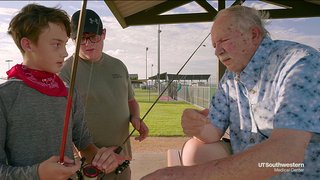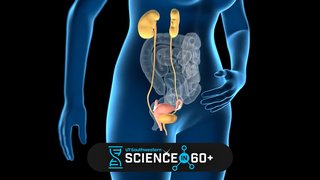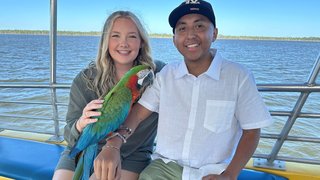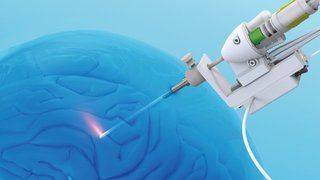Tina’s Transplant Story: A race against time and acute liver failure
April 9, 2020
When acute liver failure strikes, it’s like a bolt of lightning from a clear blue sky – one minute you’re fine; the next you’re flat on your back, fighting for your life.
Tina Bartolucci and her close-knit circle of family and friends know the reality of this all too well.
In late August 2018, she felt the beginnings of an upper respiratory infection coming on, so she loaded up on orange juice and vitamin C to try to shake it. A CrossFit fanatic in her mid-50s, Tina is energetic, athletic, and “always the light in the room,” according to her co-workers at Foot and Ankle Associates of North Texas in Keller, where she is the office manager.
But when her cough wouldn’t quit and she registered a low-grade fever, Tina decided to go to the doctor. “Sounds like walking pneumonia,” a physician’s assistant told her after listening to her lungs. He ordered labs and sent her home with a prescription for antibiotics and plenty of rest over the Labor Day weekend.
The Tuesday after the holiday, Tina’s daughter, Alice Church, went to check on her mom. Tina's eyes were yellow and jaundiced, she could barely get out of bed, and she was having trouble remembering things. Tina’s light had begun to flicker.
The PA saw the lab results and told Alice: “You need to get your mom to the hospital right now.”
Initially when Tina was admitted at Texas Health Alliance, just north of Fort Worth, doctors were concerned she was suffering from severe pneumonia. But after she failed a simple cognitive test – holding her hands out straight without twitching – an internal medicine specialist zeroed in on the diagnosis: acute liver failure.
Unlike chronic liver disease, which develops slowly and is often related to cirrhosis or scarring of the liver, acute liver failure can come on suddenly and without much warning.
“They told me (at Alliance), ‘We can’t help your mother here,’ ” Alice recalls. “We need to get her somewhere that can.”
'To think there I was, about to die, and my only chance was to have an organ donor in the same area, with the same blood type, and on the same day. For all of that to come together is nothing short of miraculous. And it really hit me, I am alive because of someone else who made the decision to be an organ donor.”
Tina Bartolucci, liver transplant recipient
A sprint to transplant
It was around 11 p.m. when Tina and Alice arrived at UT Southwestern’s Liver Transplant Unit in Dallas. The entire team – nurses, doctors, surgeons, ICU staff, social worker, psychologist, and coordinators – was there waiting.

They know when it comes to acute liver failure, it’s a race against time.
“We have a system in place where within six to 12 hours we can get patients with acute liver failure listed,” says Arjmand Mufti, M.D., a transplant hepatologist at UT Southwestern and an expert in diagnosing acute liver failure.
Dr. Mufti had conferred with the doctors at THR and quickly evaluated Tina and identified telltale signs of rapidly progressing acute liver failure:
- encephalopathy, or a decline in brain function
- her blood’s ability to clot had become significantly impaired
- her kidneys were failing
“They started working on her the second we got there,” Alice says. “I think they could tell she was going to need a transplant, but they didn’t want to scare us, so they waited until some of the big tests were completed to tell us. Then the doctors explained the operation, step by step, and the staff provided the emotional and logistical support we needed. They even explained what life was going to be like after the transplant. After talking to them, it gave us a sense of reassurance we were going to be OK.”
By 6 the next morning, the name Tina Bartolucci was on top of the liver transplant waitlist.
‘No other alternative’
Once she was listed, Parsia Vagefi, M.D., Chief of the Division of Surgical Transplantation, started notifying nearby transplant programs of Tina’s case in hopes of finding a donor liver as quickly as possible.
The majority of patients on the waiting list (12,980 in 2019 in the U.S.) have been diagnosed with chronic liver disease. A MELD (Model for End-Stage Liver Disease) score, which is based on liver function tests, is used to help determine an individual’s place on the list. The higher the score, the more urgent the need.

But patients with acute liver failure, or fulminant hepatic failure, “receive the highest priority,” said Dr. Vagefi. “It’s what we call a Status One listing. For these patients there is no waiting, because there is no alternative for them. Without a transplant, they’ll die within three to seven days.”
Tina began to show signs of worsening neurological deterioration, enough so that a breathing tube had to be placed and she had to be started on dialysis with the hopes of preventing cerebral edema, or swelling of the brain – a common and often fatal complication associated with acute liver failure.
And just when time seemed to be running out, a liver that matched Tina’s blood type and body size was identified. The only problem was it had already been assigned to another program. Dr. Vagefi called and explained the desperation of Tina’s situation.
“The other program was understanding and recognized the severity of the situation, and they allowed us to proceed and use that liver,” he said. “Their patient went on to receive a liver at a later date. Based on the rapid onset of her disease, if Tina had not received that liver, she would not have survived.”
“That liver saved her life.”
Did You Know a Single Donor Can Save Eight Lives?
In honor of National Donate Life Month, the UT Southwestern Transplant Team talks about the importance of organ donation and how in 2019 donors helped save hundreds of lives here.
‘A phenomenal recovery’
About 24 hours later, Tina slowly opened her eyes and stared up at the lights and ceiling tiles in her room at UT Southwestern’s William P. Clements Jr. University Hospital.
“I had no idea where I was and didn’t know what had happened,” she said. “Dr. Mufti told me, ‘You’re OK, you’re very sick, you’ve had a liver transplant,’ and I thought, ‘Oh, my gosh, I just thought I had an upper respiratory infection.’”

Miraculously, four days after receiving her transplant, Tina was well enough to be discharged and go home. It would be another week or so before she realized the magnitude of everything that had transpired.
“To think there I was, about to die, and my only chance was to have an organ donor in the same area, with the same blood type, and on the same day,” she said. “For all of that to come together is nothing short of miraculous. And it really hit me, I am alive because of someone else who made the decision to be an organ donor.”
Tina’s recovery has been, by all accounts, phenomenal. She recently celebrated a year post-op from her transplant. She’s back at work, back doing CrossFit, and she recently got engaged. (“We’ve already done the ‘in sickness and in health’ part,” she joked.)
Tina is quick to say she was blessed to have family and friends rally around her, and to have a medical team that was ready to rescue her from the mystifying condition of acute liver failure.
“UT Southwestern, they saved my life,” said Tina emphatically. “Dr. Mufti started paving the way for my transplant even before I arrived at UT Southwestern. The team of physicians, the nurses, I mean every single staff member was phenomenal in my care.
"I wouldn’t be here without them.”










